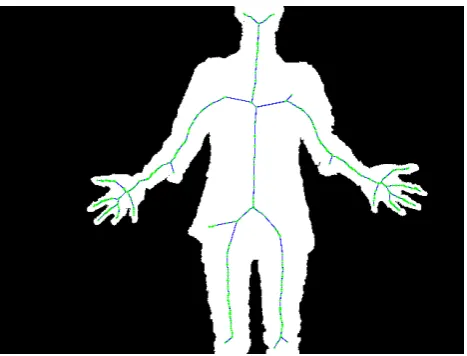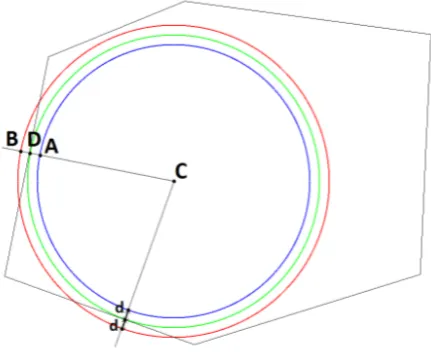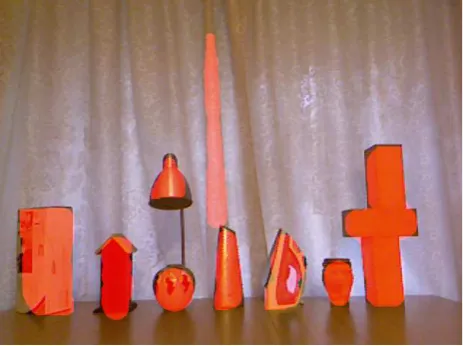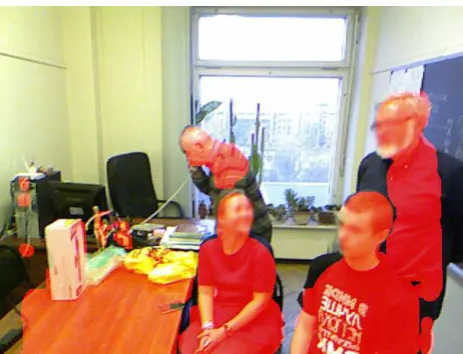FOREGROUND DETECTION ON DEPTH MAPS USING SKELETAL REPRESENTATION
OF OBJECT SILHOUETTES
D. Beloborodova, L. Mestetskiya
a
Faculty of Computational Mathematics and Cybernetics, Lomonosov Moscow State University, Moscow [email protected], [email protected]
Commission II, WG II/10
KEY WORDS:Foreground, Continuous skeleton, Medial axes, Segmentation, Kinect
ABSTRACT:
This article considers the problem of foreground detection on depth maps. The problem of finding objects of interest on images appears in many object detection, recognition and tracking applications as one of the first steps. However, this problem becomes too complicated for RGB images with multicolored or constantly changing background and in presence of occlusions. Depth maps provide valuable information about distance to the camera for each point of the scene, making it possible to explore object detection methods, based on depth features. We define foreground as a set of objects silhouettes, nearest to the camera relative to the local background. We propose a method of foreground detection on depth maps based on medial representation of objects silhouettes which does not require any machine learning procedures and is able to detect foreground in near real-time in complex scenes with occlusions, using a single depth map. Proposed method is implemented to depth maps, obtained from Kinect sensor.
1. INTRODUCTION
The problems of object detection, tracking and recognition ap-pear in many areas, such as remote control, gesture and pos-ture recognition, robotics, augmented reality and others. Most of these tasks require real-time or near real-time operation on image sequences, sometimes in high resolution. In such applications it may be useful to detect regions or objects of interest first, and then to apply further processing like object recognition or track-ing. Thus, appears the problem of foreground detection. We de-fine foreground of a scene as follows: it is a set of image regions, which correspond to the nearest to the camera objects (relative to the local background). In many cases foreground objects corre-spond to the objects of interest. Some typical examples are: a human body in front of a room wall and other objects, a human hand in front of the human body, some object on the table, etc.
Some often approaches include:
Analysis of consequent frames and background model estima-tion (i.e., as a mixture of gaussian distribuestima-tion), for example, in papers (Bondi, 2014) and (Kepski, 2014). The parameters of background model are estimated based on several last obtained frames. The pixels that don’t satisfy the model limits are con-sidered foreground. The disadvantage of this approach is its dis-ability to handle changing background: only moving objects are considered objects of interest.
Another approach uses trained classifiers like deep neural net-works to segment images, for example, in work (Gupta, 2014). This approach requires a big amount of training data and is usu-ally computational costly.
Also a graph-based segmentation is proposed in work (Toscana, 2016), which is applied to simple objects.
Many methods of object detection rely upon RGB images, but this problem becomes more complicated on images with multi-colored or constantly moving background and occlusions, when
some objects or even parts of one object may overlap. The recent development of RGB-D cameras, such as Kinect, allowed to use depth maps along with RGB images. Depth map of a scene is an array which contains information about distance to the camera for each point of the scene. Modern RGB-D cameras allow to obtain depth maps along with RGB images at high speed, in real-time.
Some known approaches to foreground or background detection on depth data are:
Using RANSAC algorithm (Fischler, 1981) to fit a ground plane to the depth point cloud or for separation of depth maps into pla-nar regions. This approach assumes that there is a ground plane in the scene, which is not always true for some applications.
Scene flow algorithms, for example, described in (Hornacek, 2014) and (Jaimez, 2015) may be used to detect motion in RGB-D scenes. This approach also considers foreground only moving objects.
Depth maps provide valuable information about distances to the objects and between them, which allows to use different approach to foreground detection, based on this information, even without RGB data.
However, foreground is not an entirely local feature, it may de-pend on neighboring regions, and simple analysis of depth steps for object borders is not sufficient for foreground detection. To overcome this problem we use skeletal representation of objects silhouettes. It allows to represent each object of a scene as a set of circles connected into a graph. We propose a method to find fore-ground of a scene, using these circles and analyzing depth steps on their edges. First, circles of skeletal representation are marked as foreground or background, and then foreground regions of im-age are reconstructed from marked skeletal representation.
data. It can handle changing or complex background and dif-ferent types of occlusions.
2. METHOD DESCRIPTION
2.1 Method Scheme
The key moment of proposed method is the construction of skele-tons for all objects in the view and also for all background areas, independent of their depth. In general, following steps are per-formed for foreground detection:
1. Borders detection and depth map binarization.
2. Calculation of the skeletal representation for the scene.
3. Estimation of foreground for the skeletal representation.
4. Foreground regions reconstruction from the skeletal repre-sentation.
2.2 Depth Map Binarization
First, borders on depth map are detected using Sobel operator. This is required to detach different objects from each other. The pixel is considered a part of the border if its value after Sobel operator application is greater than predefined threshold.
After that the depth map is binarized according to the following rule: all border pixels and pixels with unknown depth (which appear due to the features of Kinect operation) are marked black, all other pixels are marked white.
As a result of this operation we obtain a binary image with object silhouettes, divided by borders from each other.
2.3 Continuous Skeleton
A continuous skeleton of a flat figure is defined as a set of centers of all maximal empty circles, inscribed in this figure. The in-scribed circle is empty, if it does not contain any border elements of the figure. For the special case of polygon figures skeleton is represented as a planar graph. Its nodes correspond to some circles, inscribed in the polygon. Their characteristics are center coordinates, radius and two o more points of contact with poly-gon border. The graph edges are line or parabola segments.
It is possible to calculate continuous skeleton for binary image. First, all connected components borders of the image are approx-imated with polygons. Then skeletal representation is built for these polygons.
Existing algorithms allow to calculate skeletal representation for binary images effectively, in real-time. These algorithms are de-scribed in (Mestetskiy, 2009).
After binarization of a depth map, its skeletal representation is calculated. As a result of this step we obtain a graph-like struc-ture, representing skeleton of a scene.
Figure 1. Example of a skeletal representation for a binary image
2.4 Foreground Detection
We consider foreground as a set of silhouettes of objects nearest to the camera, relative to the local background. This means that foreground objects are not necessarily the closest objects in the whole scene, but rather they are situated closer than all surround-ing objects.
Let us denote skeleton node regular, if points covered with cor-responding maximum inscribed circle have smaller depth values than points outside the circle and flat figure, near its borders.
Now we will construct the formal definition of the concept of reg-ular skeleton node. Let us denote the depth at pointvasZ(v). Let’s assume that a node with coordinates(x0, y0)has a corre-sponding circle inscribed in polygonal figure with radiusRand center in this node. This circle contacts figure borders at least in two points. Let’s denote the set of points inside this circle as CR. Let’s construct a new circle with center in(x0, y0)and ra-diusR+ε, whereεis a small positive number. Let’s denote the set of points inside this circle asCR+ε.
Boundaries of a polygonal figure divide areaCR+ε to several areasA0, A1, . . . , Ak, and exactly one of them contains whole CR area (that is because the circle is inscribed). Let’s assume CR ⊆ A0and define regionAas:
We will consider this node regular if with smallεwe can find such positive numberhindependent ofεwhich satisfies the inequality:
min
v∈AZ(v)>vmax∈CR
Z(v) +h (2)
This inequality means that at border fragments which contact the inscribed circle there is a depth step. And on the way from inside the circle through the contact point depth increases.
First we find all points of contact for the corresponding inscribed circle and the border of the figure. Information about contacting border elements is collected during the construction of skeletal representation. Knowing the type of border element (vertex or edge) we can calculate the coordinates of contact with inscribed circle.
Let’s consider a skeleton node. Let’s assume thatC is a cen-ter of corresponding inscribed circle, andD is a contact point. Next, values of depth are obtained from pointsAandB which are located onCD line at a small fixed distancedfrom point D. We assume that point A is inside the maximum circle, whileBis outside it. We denote coordinates ofA, B, C, Das
(xA, yA),(xB, yB),(xC, yC),(xD, yD)respectively.
Figure 2. Illustration for foreground calculation procedure
Then coordinates of pointsAandBcan be calculated as:
kout= 1 +p d
(xD−xC)2+ (yD−yC)2 (3)
kin= 1−p d
(xD−xC)2+ (yD−yC)2 (4)
xA=kinxD+ (1−kin)xC (5)
yA=kinyD+ (1−kin)yC (6)
xB=koutxD+ (1−kout)xC (7)
yB =koutyD+ (1−kout)yC (8)
We denote depth at pointsAandBasZinandZoutrespectively, and we call valueZ=Zout−Zinthe depth step for this contact point.
Then if the depth step for all contact points is positive, the node is considered regular. Else it is considered non-regular. It’s clear
that regular nodes correspond to areas that are closer to camera, than surrounding background.
If the depth step of current contact point is close to zero, then it is related either to the noise in data or object surface local rough-ness. If the depth step if rather high, then contact point is located on the border of the object with background or another distant object.
Let’s pick two values for depth thresholds:0≤Zlow < Zhigh. We will consider foreground only skeleton nodes with all contact points satisfying inequality:
Zlow< Z < Zhigh (9)
Changing these thresholds, we may select different objects of foreground. Zlow parameter is used to decrease noise and in-crease stability of the foreground detection algorithm. When we decreaseZhigh, objects in front of distant objects are no more considered foreground. This feature can be used to detect occlu-sions of close objects (like hands in front of body) and to ignore all other objects.
Figure 3. Regular edges (blue) and non-regular (green).
Let’s construct foreground skeleton as following: its nodes are all skeleton nodes with all contact points satisfying inequality Zlow < Z < Zhigh. The edges of foreground skeleton are all skeleton edges incident to any of chosen nodes.
2.5 Foreground Reconstruction
Next we need to reconstruct silhouettes of foreground objects us-ing the correspondus-ing foreground skeleton. We use foreground skeleton edges to reconstruct areas corresponding to the fore-ground.
Let’s assume that the edge is incident to two nodes with coor-dinates(xa, ya)and(xb, yb)with inscribed circles with radiiRa andRbcorresponding to them respectively. For each point of this edge there is some corresponding inscribed circle. We suppose that radii of such circles change linearly fromRatoRbalong the edge.
denote distance from point(x, y)to the closest point on this edge asρ. Then we define if the point is at foreground as following:
t= (xa−x)(xa−xb) + (ya−y)(ya−yb) (xa−xb)2+ (ya−yb)2 (10)
R=
(1−t)Ra+tRb, t∈[0,1]
Ra, t <0
Rb, t >1
(11)
Then(x, y)is at foreground, ifρ≤R.
Here valuetis a parameter for the location of projection of point
(x, y)on the edge, andRis the radius of inscribed circle for this projection.
To determine if the point(x, y) is foreground, it is enough to check the inequality for this point for all foreground skeleton edges.
Alternatively, for each foreground skeleton edge we can consider a set of points(x, y):
min(xa−Ra, xb−Rb)≤x≤max(xa+Ra, xb+Rb) (12)
min(ya−Ra, yb−Rb)≤y≤max(ya+Ra, yb+Rb) (13)
and check the inequalityρ≤ Rfor current edge only for these points. All points from this set that satisfy the inequality are marked as corresponding to foreground.
3. METHOD IMPLEMENTATION
This method was implemented to the depth maps obtained from RGB-D sensors Kinect and Kinect v2 and tested. It is able to detect foreground in near real-time (up to 15 fps, depending on actual number of objects in the scene) and showed rather stable results.
This method does not depend on color or texture of the scene and does not require limitations for camera position or movement.
The method deals with complex scenes, containing many differ-ent objects, independdiffer-ent of their depth.
It is possible to find foreground for a scene with occlusions, for example, a scene with many people present.
This approach may be used as a pre-processing method for com-puter vision, remote control and augmented reality systems. For example, it may be used to locate objects of interest and calculate their bounding boxes.
The method still has some trouble with detecting false positive which appear due to the unknown depth values in received depth data. The reconstruction of foreground areas as also a bit rough, because foreground pixel areas are constructed through skeletal representation, and thus are not entirely precise.
Figure 4. Detected foreground relative to human body
Figure 5. Detected foreground of a complex scene
Figure 6. Corresponding foreground skeleton
4. CONCLUSION
pro-Figure 7. Detected foreground of a scene with several people
Figure 8. Corresponding foreground skeleton
cedures and is able to calculate foreground, using a single depth map. It is robust to scene texture, light conditions and camera position.
It may be used for object detection and tracking, gesture and pos-ture recognition, augmented reality systems as a first step to lo-cate the regions of interest.
The future work will include exploring more robust approaches to detect foreground for skeletal representation and application of this method to augmented reality systems.
REFERENCES
Bondi, E., 2014. Real-time People Counting from Depth Imagery of Crowded Environments. Technical report, University of Flo-rence.
Fischler, M., 1981. Random sample consensus: A paradigm for model fitting with applications to image analysis and automated cartography. Technical report, Commun. ACM.
Gupta, S., 2014. Learning Rich Features from RGB-D Images for Object Detection and Segmentation. Technical report, European Conference on Computer Vision (ECCV).
Hornacek, M., 2014. Sphereflow: 6 dof scene flow from rgb-d pairs. Technical report, IEEE Conference on Computer Vision and Pattern Recognition (CVPR).
Jaimez, M., 2015. A primal-dual framework for real-time dense rgb-d scene flow. Technical report, IEEE International Confer-ence on Robotics and Automation (ICRA).
Kepski, M., 2014. Person Detection and Head Tracking to Detect Falls in Depth Maps. Technical report, University of Rzeszov.
Mestetskiy, L., 2009.Continuous Morphology of Binary Images: Figures, Skeletons, Circulars. Fizmatlit, Moscow.



